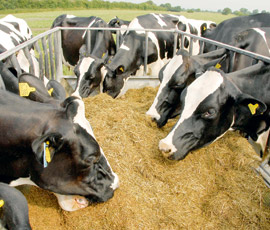Forage quality good, but watch for high starch

First analyses of fermented wholecrop and maize silages will provide a welcome relief for dairy farmers, with results showing general forage quality is good.
However dairy farmers are being advised to pay close attention to rumen health to counteract acidosis as a result of high starch content in maize.
John Allen, Technical Director with Frank Wright Trouw Nutrition International, says that overall fermented wholecrop is slightly poorer than 2012 as a consequence of the slow and difficult start to the season. Dry matter is down by 3.5% on average, starch is down by 4.5% and ME is 0.2MJ/kg DM less.
“The lower dry matter and starch content mean that wholecrops will provide less rumen fermentable carbohydrate than last year and will reduce the supply of glucogenic energy.”
However, the first 600 maize silages analysed show an excellent crop says Mr Allen. Samples have been received earlier due to better harvest conditions and use of early maturing varieties. Dry matter is higher at 30.8% and ME is 11.4MJ/kg DM compared to 11.2MJ/kg DM last year.
MAIZE AND WHOLECROP SILAGE COMPARISON | ||||
Fermented wholecrop | Maize | |||
2012 | 2013 | 2012 | 2013 | |
Dry matter (%) | 43.6 | 40.1 | 29.5 | 30.8 |
D value (%) | 66.5 | 65.2 | 70.8 | 72.2 |
ME (MJ/kgDM) | 10.4 | 10.2 | 11.2 | 11.4 |
Crude protein (%) | 9.2 | 9.5 | 8.5 | 7.6 |
Starch (%) | 23.7 | 19.2 | 27.6 | 34.5 |
NDF (%) | 44.5 | 49.4 | 50.7 | 45.1 |
The most significant change is in starch which has increased from 27.6% to 34.5%, while neutral detergent fibre (NDF) has reduced from 50.7% to 45.1%.
“Maize crops will provide a highly concentrated form of starch and the introduction of maize should give milk production a welcome boost. However, it may prove difficult to balance, from a rumen health perspective,” says Mr Allen.
“The high starch combined with higher dry matter degradability and reduced NDF could lead to problems such as sub-clinical acidosis. Sample clamps regularly and revise rations based on the latest information as the degradability of starch increases with time in the clamp.”
Dr Allen says as forage typically supplies 50% of dry matter intakes, the quality and quantity of silages made this year could contribute to an improvement in profitability. However, he warns that careful rationing and balancing will be required to turn this potential into actual higher production and reduced purchase feed use.
